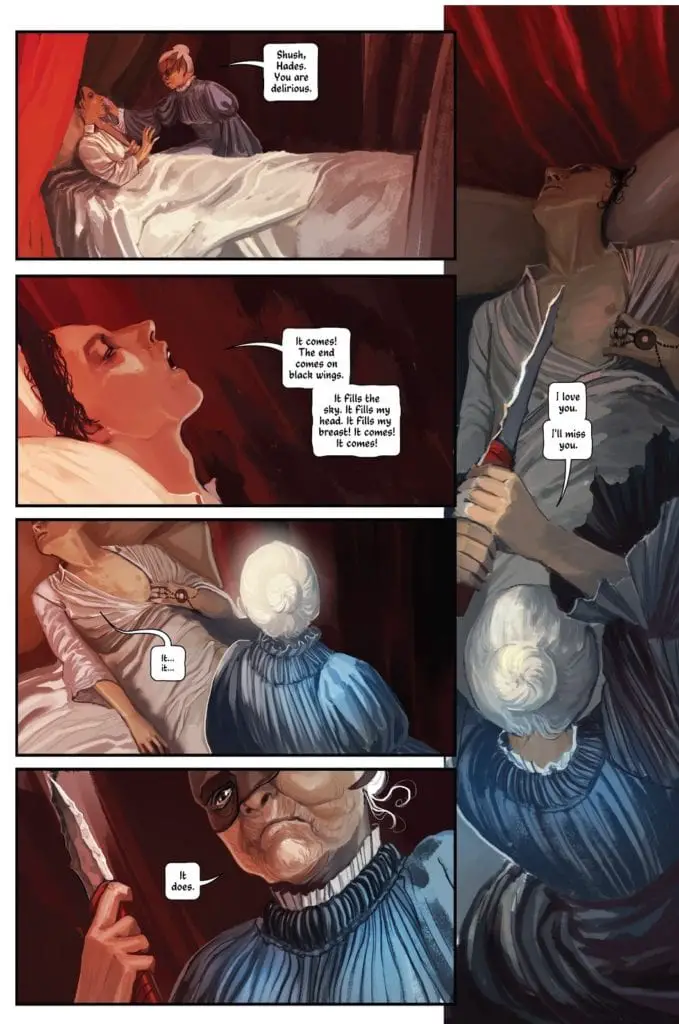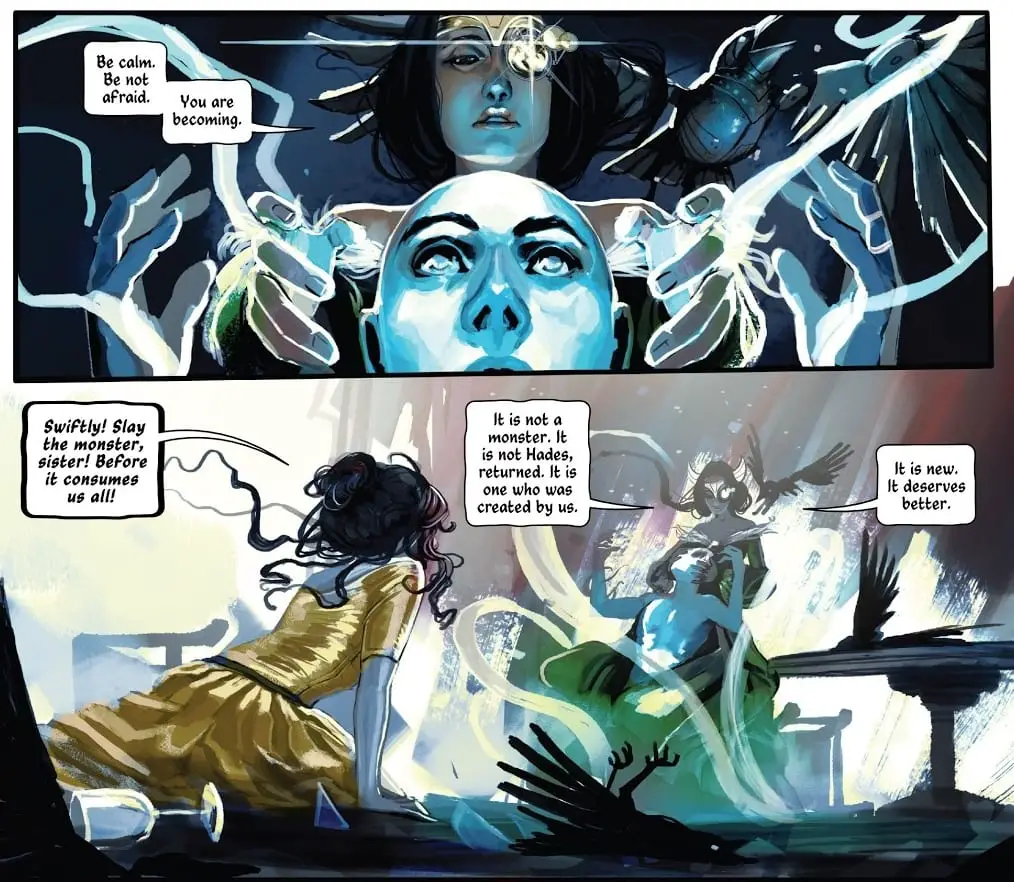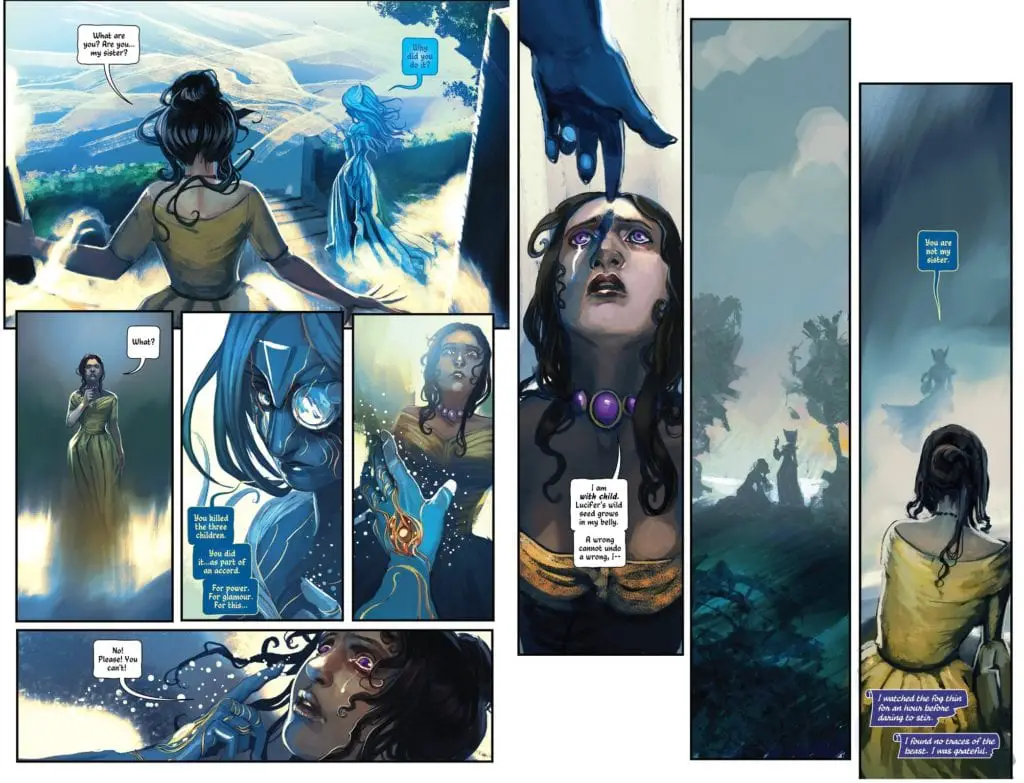The Rising Action arc was quite the example in terms of momentum in comic book narrative. Suspense and miscommunication helped outline the true state of affairs in previous arcs. At first sight of certainty, the events rushed furiously to their conclusion: the death of Ananke and the destruction of her scheme. And now, we’re back in the dark. The villain is dead, but we find that the sound and the fury signified nothing, because vengeance was not so much a matter of understanding as it was of emotion. Was Ananke’s plan a matter of sheer spite for the youth and lust for power? Or could it have been a necessary evil to resist an even greater one? When in doubt, it’s best to mark some distance, and to observe previous and similar instances.
It’s so that we’ll explore the first special one-shot of The Wicked + The Divine. For this occasion, Stephanie Hans’ palette will grace the recurrence of an age past.
1831
“You will go on long after we’re gone.”

The era of the romantics is especially known by its fatalism. Its bright minds were prone to burn bright and fade out quickly. So, even if the Recurrence’s rules dictated that the Gods would die within two years, all were likely to meet that end, God or not. Thus, it’s more than fitting that we meet our first God in their death bed. Much like personal favorite, John Keats, Hades is on the threshold of death by tuberculosis in Rome. Ananke is by his side to hear his final delirious words. The end is coming on black wings, filling everything. Whether he means his own end, or a finality on a greater scope, we don’t know for certain. Nonetheless, with loving words, Ananke finishes him with her dagger. Unlike the deaths she’ll be responsible for in the future, this one does feel merciful.
It’s March 11, 1831, and only four Gods remain alive. By the narration of this Recurrence’s Inanna, it seems that this generation is on the threshold of death, with only a few hours remaining. So, they entertain themselves in Villa Diodati on the Lake Geneva, as romantics do. This time, Inanna bears resemblance to Claire Clairmont. So it makes sense that her lover, Lucifer, takes after Lord Byron with his demeanor and excesses. I think the point is clear, that the all Gods take after important literary personages of the time. This certainly fits the notion that literature was considered Promethean, therefore transgressive through the affirmation of the individual’s agency and capabilities. Furthermore, the praise of nature in Romanticism certainly fits the image of the Gods as traditional personifications of the forces of nature.
Let’s consider the setting. According to historical accounts, Byron, Mary and Percy Shelley, and others spent a lovely night at Lake Geneva. The event sparked a genesis of some of the most famous literary creations, particularly in the vein of horror. Both Frankenstein and The Vampyre subvert the finality of death and the role of humanity as per the standards of the Catholic Church. By this reference, the Gods’ stay at Lake Geneva represents the poets’ challenging the standards of the age. All in all, it feels appropriate that poets would become Gods in this age. It’s no less an exciting time to be a God than in the 21st Century’s ‘cult of the popstars’, but I digress.
Ananke is outside, which greatly troubles Inanna, as the Goddess of Necessity’s coming means death. However, Lucifer is not really concerned, as he calls her “a helping hand” for the night’s events. In context, this most likely means a party with a high dose of debauchery to preface their death. It’s interesting to note that one of the deceased Gods seems to take after William Blake. Later that day, Inanna runs into her sisters, Woden, and Morrigan, who look like Mary and Percy Shelley. As opposed to the Woden of our age, this Woden doesn’t care much for excess and partying. Nonetheless, she still joins the others for their entertainment at the table. Much like their real-life counterparts, they seem to be in the middle of telling horror stories.
Inanna’s is not much of a story itself as a reference to the real drama occurring between the Shelleys mixed with their ascension to divinity. Woden takes offense at Inanna’s rather petty narration, so she retorts with a ‘tale’ of her own. This one is miles past the ache of jealousy, as she tells of her own experience losing every child she’s given birth to, by basically birthing ash. The reference to Mary Shelley’s three deceased children is quite clear and suitable for Woden’s perspective on their coming death. Lucifer doesn’t derive much amusement from Woden’s tale, so he recounts the deaths of their peers. An unnamed threefold Goddess that may be the Norns (The Brontë Sisters), Morpheus (William Blake), Thoth (Edgar Allan Poe), Hestia (Jane Austen), and Perun (Aleksander Pushkin).
And finally, Hades. They didn’t know about this one until Lucifer broke the news to them. Naturally, all mentions to these Gods reference either the artists’ body of work or the way they died. As it turns out, the recounting of their lost friends served a greater purpose. A powerful preface to something Lucifer and Morrigan had been planning. Ananke knew of this and supplied the means via Hades’ hand. This is not the Prometheus Gambit, but Necromancy to revive their recently deceased fellow. Woden wants no part of it, and tries to talk Inanna into walking away, to no avail. When completed, the ritual seems to have worked. Morrigan effectively reprises and subverts his very own “Ozymandias” by telling his wife to “look upon his works and hope”. However, much like Ozymandias himself, this is not to last.

This isn’t Hades, but the Creature brought back to life through unnatural means. Lusting for life, the Creature kills both Lucifer and Morrigan. Before it can claim Inanna as well, Woden soothes their creation, sacrificing her life in the process. This is quite a beautiful and brutal way to metamorphosize, or rather materialize the author taking ownership of her work.
Horrified by this turn of events, Inanna follows the creature, now bearing Woden’s image, to the lake. The creature confronts Inanna with a terrible knowledge she’d kept hidden. Inanna had been responsible for the deaths of her sister’s children, all as a price to buy her divinity. Before the Creature kills her, she reveals that she’s pregnant with Lucifer’s child. This would be the equivalent to Allegra, Lord Byron and Claire Clairmont’s daughter.
The Creature walks away after this revelation, rejecting its creators, who really were Gods. After the event, Inanna reflects on these events as she writes them down. The destinations of Lucifer and Morrigan’s remains take after their real-life counterparts’, while her sister’s creation roams the world, figuratively, to this very day. She thought she had saved herself from the death coming their way, until Ananke arrives to her side. She snaps her fingers, and the rest is history. This Recurrence’s Pantheon is dead. The world will know no Gods until ninety years later, in a new century, and so forth.
I bring the review on this issue to an end with praise. Every once in a while, I read or watch something that feels right on so many levels, and it stays with me. As far as generating one single narrative from the threshold between real life and the art it begets, Neil Gaiman may still stand alone through The Sandman. However, this special is, to me, a taste of the same kind of ingeniousness. A dash of that peculiar something we dare call ‘genius’. Beauty is truth, and truth is beauty. as John Keats declared in his “Ode on a Grecian Urn”. This strikes perfectly true when considering that the greatest of stories outlive the author and cast influence on the world, much as Woden/Mary Shelley’s ‘creature’.

More than a simple mixture of reality with the fantasy of WicDiv, this is a tribute to that Promethean character of art. To challenge mortality, and to immortalize the artist, who are effectively Gods.
The Wicked + The Divine 1831 Credits:
Writer: Kieron Gillen
Art: Stephanie Hans
Cover: Stephanie Hans, Jamie McKelvie, Matt Wilson
All images are courtesy of Image Comics

